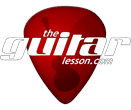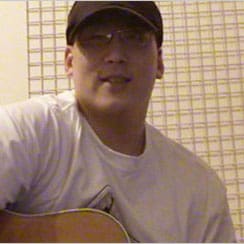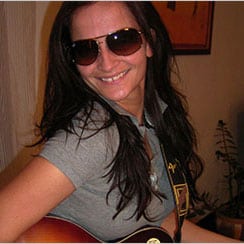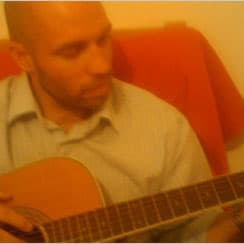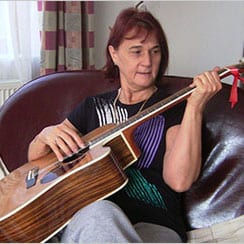Learning guitar theory, so music theory specific to the guitar, will free up your playing and take your performance level to previously unimagined heights. Learn the basics with our online beginner guitar lessons, and in the meanwhile, start learning the music theory of playing the guitar as well.
If you want to improvise solos, make up your own licks, or write your own songs, you'll need to understand music theory for guitar.
You should first of all start out with the most basic concept, learning the notes on the guitar. It is only after this, that you should move on to the rest of the guitar theory lessons.
Guitar chords
Learning to read chord charts is one of the first things you'll need to do as a beginner guitarist. You'll be using them for the rest of your guitar-playing life actually.
Chord diagrams can be a bit weird to the untrained eye, so let’s learn how to read chord diagrams.
Learning guitar chords (sometimes misspelled as guitar cord) is one of the first steps a beginner guitarist will take in learning to play the guitar.
Learning chords will already enable you to play real music and songs, which is really the reason you picked up the guitar in the first place.
Through learning guitar chords theory, you will be able to understand how chords on the guitar are constructed. You'll learn to create chords all over the fretboard, once you know how to construct chords as well.
As a beginner guitarist, this is not that relevant, but as you advance in your guitar studies, you will want to do more than just play chords, you’ll want to understand why your favorite songs sound the way they do.
A power chord is not a real chord, it's actually a diad, which is 2 notes played together. Guitar power chords are very versatile, since the shape can be moved all over the fretboard.
Power chords are mostly played on electric guitars under distortion. Mostly rock and heavy metal guitar players use power chords, since it gives a low, aggressive sound under distortion, and give a feeling of raw power.
Barre chords (often written as bar chords) are very versatile guitar chords, which are movable to any fret on the fretboard in a given shape.
Barre (bar) actually refers to the positioning of the index finger of your fretting hand, which must be laid across and holding down several strings at once.
Chord progressions are a series of guitar chords played in a set sequence on a scale, usually consisting of 2,3 or 4 chords. Read on to learn some popular chord progressions, which you will learn to play in any key you want.
To fully understand how you can build chord progressions, you first need to be familiar with guitar scales and chord theory.
As a guitarist, it's important to know what chords are in which key. Find the chords, theory, and detailed explanation of why each chord is in a given key:
Chords in the key of C major >>
Chords in the key of A major >>
Chords in the key of G major >>
Guitar scales
The major scale is your starting point should be the first scale you learn.
It is THE basis of chords and other types of scales, and actually the basis of Western music as we know it. If you learn the major scale, you will be able to understand how chords are constructed, know why your favorite songs sound the way they do, play great arpeggios, and be able to write your own songs.
The minor scale should be the second scale you learn, it is the most used scale after the major scale.
It is formed from the 6th degree of the major scale, so if you took the time to really learn the major scale across the fretboard, you are half way in knowing the minor scale already.
A pentatonic scale is like any other scale (notes separated by intervals), but it contains just 5 tones, as opposed to the major scale and it's modes, which have 7 notes. Because of this, pentatonic scales are an “economy” version of the bigger major and minor scales.
Pentatonic scales are used very-very often in jazz, blues and rock, and across other genres as well, and is used for soloing.
This practical guide to using the minor pentatonic scale, one of the most popular scales, will be of true benefit to you once you are familiar with your basic lead guitar techniques.
You’ll will now learn to use the scale all over the fretboard, the 5 shapes of the scale, and how to connect the shapes to create awesome solos.
Minor pentatonic scale shapes and patterns >>
If you want to see the notes of the minor pentatonic in any given key, click below:
This tutorial will give you an introductory overview of the different modes of the major scale.
Each mode starts off of a different note of the major scale, thus each of the 7 guitar modes is a derivative of the major scale. This may seem like a small change, but you’ll hear that because of these one note changes, each mode will have a distinctive atmosphere and mood to it, which you can use in your music.
CAGED system
Guitar anatomy isn’t exactly a college subject, but it’s still important to know the parts of the guitar. Knowing how something works is important if you The CAGED system is a simple and elegant way to understand the fretboard and how chords are formed. It's easy to learn and once you understand it, you'll be able to visualize any chord on the fretboard.
Learn the CAGED system and how to use it >>
Guitar Anatomy
Guitar anatomy isn’t exactly a college subject, but it’s still important to know the parts of the guitar. Knowing how something works is important if you want to master it, so let's have a look at the anatomy of the guitar.
Anatomy of the acoustic and electric guitar >>
How to Read Guitar Tabs
Guitar tabs (which is short for tablature) is a type of musical notation for stringed instruments that show you which fret to play on each string, as opposed to standard staff notation, which shows you the pitch of a note. Beginner guitarists have a much easier time learning from tablature, but in the long run, it’s a good idea to learn the standard musical notation as well.
Arpeggios
An arpeggio on the guitar is very similar, but also very different from a chord.
When you play an arpeggio, you are using the notes of a chord, just not all at once, since you pick the individual notes of the chord separately. You can use arpeggios to play really great chord melodies, you hear them in really famous songs all the time.
